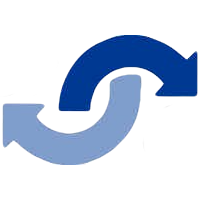
As we entered a new year and a new decade, we as a global society were thrown into unprecedented times with the outbreak of the COVID-19 virus. Employers are still reeling from adjusting to a work-from-home structure, an uncertain future and for some, complete shutdown and the letting go of valuable employees.
Coming out of all the turbulence, are countless new opportunities for organizations to uncover a new way of work.
One such opportunity is using this interim period to review and take inventory of processes, templates and other supporting and supplementary documents that are currently in place.
At Career Contacts, we continue to grow our team slowly, and strategically. Most recently, adding a Director of Partnerships, to support our clients in their need to create a new way of work – one that is organized, and optimized, for the future of work.
These reviews will allow organizations to identify the current state of affairs, and determine what gaps there are.
The next stage would be to implement the required changes and begin to create new tools as needed.
You know, all the things that we say we will do when we have time, when things slow down, when the high priority stuff clears? All that work that sat on the side of our desks? Here is the chance to get organized, optimized, and ready to gear up while we, as a collective, establish a new normal.
While we cannot deny the sheer upheaval that this pandemic has caused for us, we can take this slow down as a means of improving and bolstering our operations and the tools that support us day to day.
Here are ten steps that can get you and your team started today:
ONE – Take a second to reflect
Run through your day – what roadblocks do you come across, what stalls you, what issues do you face?
TW0 – Take stock
What processes, documents, templates do you have currently? As you take this inventory, it is amazing to see how many duplications, contradictions and cross functionality can be revealed.
THREE – Whiteboarding/brainstorming session
Virtually of course, gather key team members and stakeholders to discuss their experiences, what they feel is working and what is required to promote efficiency, supports positive workflow and any other innovations they have in mind. The people who are engaged with these artifacts daily are your greatest data points and will provide you with the most candid and valuable information.
FOUR – Planning and strategy session
Once you have determined what you need and what needs to be done, gather the troops to figure out timelines, approach, inter-dependencies, and assign specific tasks.
FIVE – Get to work
Have fun with this as you collectively develop, revise, rework and establish these processes and tools. It is your time to make things really work for you so throw yourself into it and see the evolution of the elements that make up your day to day.
SIX – Check-in
Research and experience shows that initiatives such as this can fall flat if the teams are not discussing the current state, any blockages, questions, issues, risks, inconsistencies that have arisen during this key revision and development time. Have the team collate once a week, preferably at the start, to outline the current state of their task, what is outstanding, and any other specifics. Not only will this drive progress but allow people the space and opportunity to collaborate and overcome any roadblocks that they have encountered.
SEVEN – Presentation for feedback
Once the specific process, template, tool etc., is complete, have the responsible team members present it to the larger group/managers/executives, depending on your organizational structure. This presentation should include some background, whether this was developed completely new or based on previous components, development methodology, its purpose and how to use. The second part of this is to allow for others to provide inputs and edits and ask clarification questions for refinement and moving towards finalization.
EIGHT – Editing and finalization
Post-presentation, the development team or resource will take the feedback and revisions provided by the team and implement the changes and complete a final read through and review to finalize.
NINE – Approval
Once the process/template/document/tool is complete, submit to the correct team member or department for final review and approval. Once approval is granted, place the completed piece in the correct folder, file, upload to SharePoint or wherever the appropriate knowledge management space is for your company.
TEN – Training
Depending on your organization’s structure or department hierarchy, to ensure that all team members are apprised of your new tool, it would be advantageous to host a virtual training session. Not only is it a chance for team members to connect, it ensures that everyone understands its purpose, usage and allows for a question and answer period.

This list is not meant to be exhaustive, but a starting point depending on how your teams and companies are structured. By equipping our HR Consulting division with a Director of Partnerships, we have added the ability to not only be a human resources business partner, but an overall addition to your senior management and leadership teams.
Needing some support in getting started?
Our team can assist in providing reviews, field any questions, have strategy calls or provide any clarification or advice as required.
Please feel free to reach out and we at Career Contacts would be happy to help.

